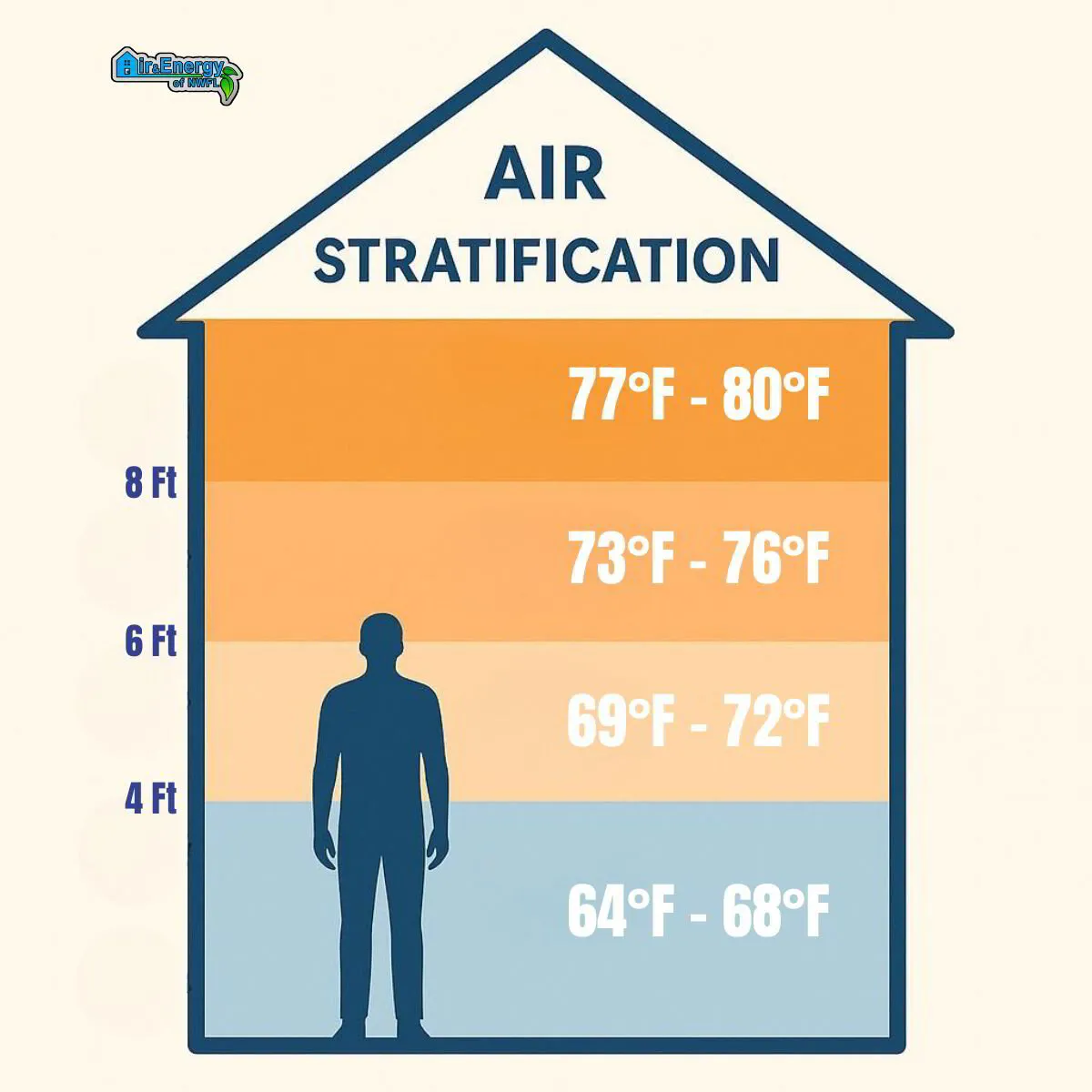Ever notice how the ceiling feels warm but your feet are freezing? That’s air stratification, when warm air rises and cool air sinks, creating uneven temperatures in your home. It’s not just uncomfortable; it can also drive up your energy bills.
In this article, we’ll explain air stratification, why it happens, and how to fix it. From simple DIY tricks to smart HVAC upgrades, we’ve got practical tips to help you stay comfortable year-round.
What is Air Stratification?
Air stratification is the natural layering of air at different temperatures, where warm air rises and cool air settles near the floor. This temperature layering, also known as thermal stratification, leads to uneven indoor comfort, especially in rooms with high ceilings or poor airflow. As heat accumulates near the ceiling and cooler air stays below, your HVAC system may work harder to balance the temperature, causing energy inefficiency and higher energy consumption.
How Does Air Stratification Happen?

Air stratification occurs because warm air naturally rises while cooler, denser air sinks. This imbalance becomes more noticeable in homes with high ceilings, poor air distribution systems, or inefficient HVAC design.
The hot air collects near the ceiling without proper airflow, while colder air stays trapped below. Poorly placed vents or a lack of zoning can worsen the issue. Homeowners should care because this results in discomfort and rising heating or air conditioning costs.
How Air Stratification Affects Comfort and Energy Costs
Air stratification can make your home feel uncomfortable no matter how high you set the thermostat. One common sign is a noticeable ceiling-to-floor temperature differential. You crank the heat, but your toes stay cold while the air temperatures above feel much warmer. This uneven heating is often due to HVAC stratification, where your system struggles to distribute air evenly.
Poor air circulation allows hot air to rise and sit near the ceiling, leaving living areas chilly. As a result, your air conditioning or heating system runs longer trying to correct the imbalance, wasting energy and driving up utility bills. Over time, this reduces energy efficiency and adds wear and tear to your equipment. Addressing air stratification improves comfort, protects your HVAC system, and saves on energy costs.
Common Areas in the Home Impacted by Stratification
Air stratification often occurs in areas where airflow is limited or air temperatures naturally fluctuate. Common trouble spots include:
- High ceilings – Warm air rises and stays trapped overhead, leaving lower areas cool. In fact, temperature differentials from thermal stratification can reach up to 1.5°C (2.7°F) per vertical foot, which means serious discomfort and energy waste in rooms with vaulted or two-story ceilings.
- Open-concept living spaces – Fewer walls mean less control over air movement, leading to uneven temperatures.
- Stairwells – Vertical spaces allow warm air to drift upward, creating hot and cold air layering.
- Attics and upper floors – These spaces trap heat, especially without proper insulation or ventilation.
- Basements – Naturally cooler and harder to heat evenly from above.
- Greenhouses or sunrooms – Large windows and sun exposure lead to rapid temperature swings.
Poor insulation and a lack of HVAC zoning can make these problems worse by preventing consistent airflow and temperature control.
How to Identify Air Stratification in Your Home
To check for air stratification in your home, use a thermometer to compare air temperatures near the ceiling and floor. A significant difference may indicate temperature layering. Look for persistent hot or cold zones, especially in rooms with high ceilings.
Uneven comfort across floors or spaces can also signal poor indoor air circulation. Check your vents and HVAC performance to ensure air movement is reaching all parts of your home.
Solutions to Fix or Prevent Air Stratification
Destratification fans help push hot air down from the ceiling and mix it with cooler air below, eliminating temperature layering. They're especially useful in spaces with high ceilings like garages, workshops, or large living rooms. These fans improve comfort and reduce strain on your HVAC system.
Upgrading your HVAC system is a long-term solution to air stratification. HVAC zoning lets you heat or cool different areas independently, improving air mixing and comfort. Rerouting or resizing ductwork can also help balance airflow and prevent certain rooms from getting too hot or too cold.
You can make quick improvements by reversing your ceiling fan to push heated air down, adjusting vents to balance airflow, or moving furniture away from vents and returns. These small changes can reduce temperature differentials and improve comfort without major costs.
If you're still noticing uneven temperatures, it’s time to have an HVAC professional assess the situation.
Final Thoughts
Fixing air stratification improves comfort, lowers energy bills, and helps your HVAC system run more efficiently. Even small changes can make a big difference; professional help is just a call away when needed.
🐊 If you're a Pensacola homeowner, schedule an energy audit with Air & Energy of NWFL to get expert solutions tailored to your home.

This article was written by:
Co-founder and Home Comfort Specialist

